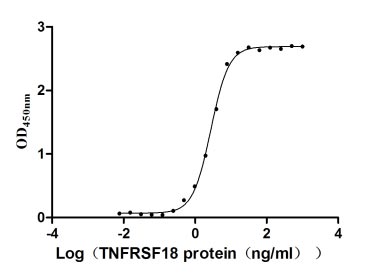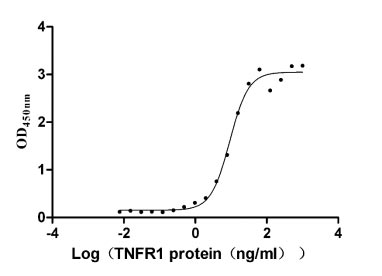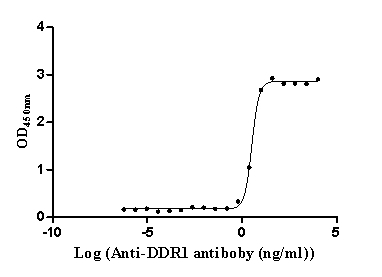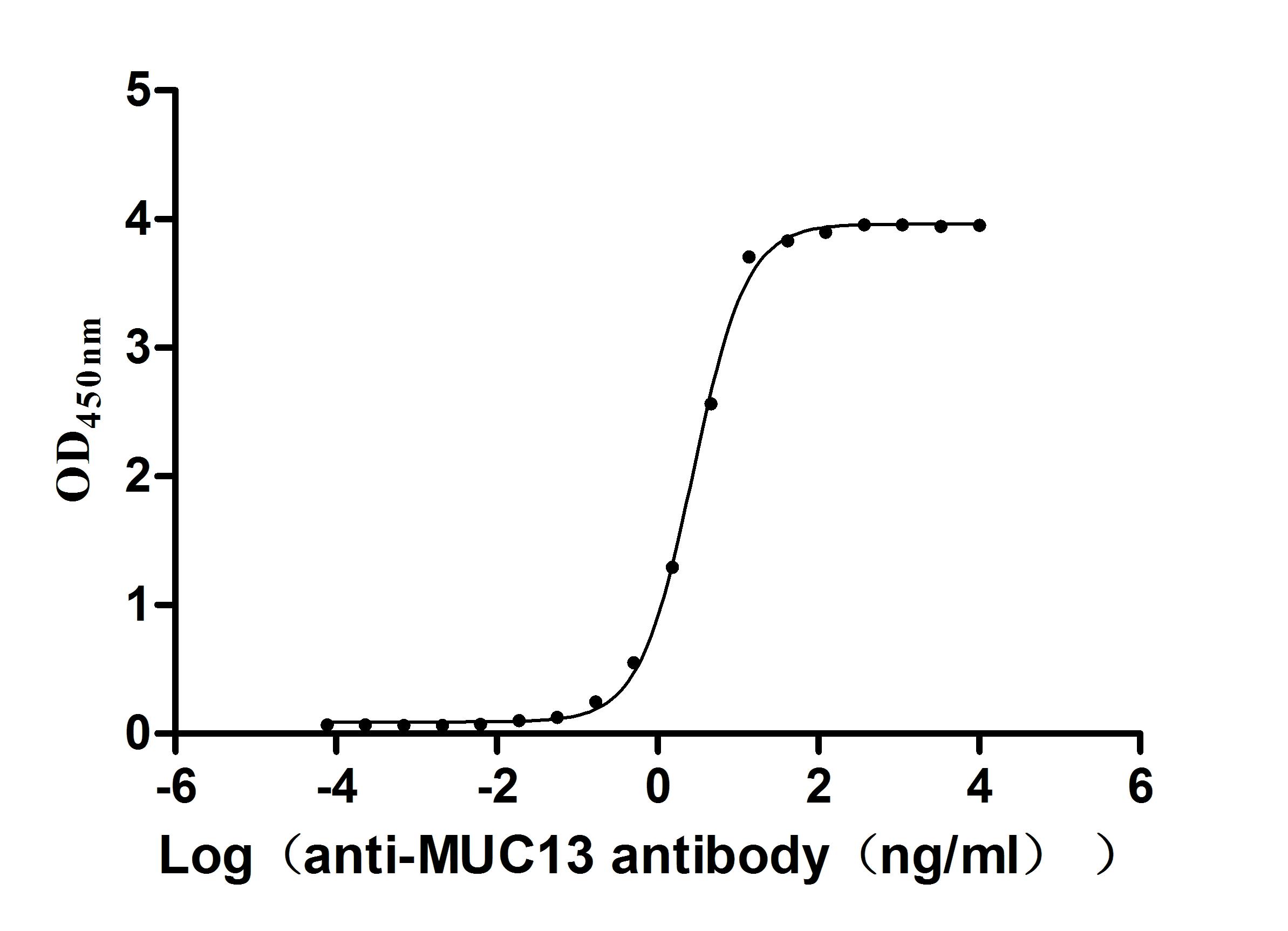Recombinant Mouse ATP-binding cassette sub-family G member 5 (Abcg5), partial
-
货号:CSB-YP858786MO1
-
规格:
-
来源:Yeast
-
其他:
-
货号:CSB-EP858786MO1
-
规格:
-
来源:E.coli
-
其他:
-
货号:CSB-EP858786MO1-B
-
规格:
-
来源:E.coli
-
共轭:Avi-tag Biotinylated
E. coli biotin ligase (BirA) is highly specific in covalently attaching biotin to the 15 amino acid AviTag peptide. This recombinant protein was biotinylated in vivo by AviTag-BirA technology, which method is BriA catalyzes amide linkage between the biotin and the specific lysine of the AviTag.
-
其他:
-
货号:CSB-BP858786MO1
-
规格:
-
来源:Baculovirus
-
其他:
-
货号:CSB-MP858786MO1
-
规格:
-
来源:Mammalian cell
-
其他:
产品详情
-
纯度:>85% (SDS-PAGE)
-
基因名:
-
Uniprot No.:
-
别名:Abcg5; ATP-binding cassette sub-family G member 5; Sterolin-1
-
种属:Mus musculus (Mouse)
-
蛋白长度:Partial
-
蛋白标签:Tag type will be determined during the manufacturing process.
The tag type will be determined during production process. If you have specified tag type, please tell us and we will develop the specified tag preferentially. -
产品提供形式:Lyophilized powder
Note: We will preferentially ship the format that we have in stock, however, if you have any special requirement for the format, please remark your requirement when placing the order, we will prepare according to your demand. -
复溶:We recommend that this vial be briefly centrifuged prior to opening to bring the contents to the bottom. Please reconstitute protein in deionized sterile water to a concentration of 0.1-1.0 mg/mL.We recommend to add 5-50% of glycerol (final concentration) and aliquot for long-term storage at -20℃/-80℃. Our default final concentration of glycerol is 50%. Customers could use it as reference.
-
储存条件:Store at -20°C/-80°C upon receipt, aliquoting is necessary for mutiple use. Avoid repeated freeze-thaw cycles.
-
保质期:The shelf life is related to many factors, storage state, buffer ingredients, storage temperature and the stability of the protein itself.
Generally, the shelf life of liquid form is 6 months at -20°C/-80°C. The shelf life of lyophilized form is 12 months at -20°C/-80°C. -
货期:Delivery time may differ from different purchasing way or location, please kindly consult your local distributors for specific delivery time.Note: All of our proteins are default shipped with normal blue ice packs, if you request to ship with dry ice, please communicate with us in advance and extra fees will be charged.
-
注意事项:Repeated freezing and thawing is not recommended. Store working aliquots at 4°C for up to one week.
-
Datasheet :Please contact us to get it.
相关产品
靶点详情
-
功能:ABCG5 and ABCG8 form an obligate heterodimer that mediates Mg(2+)- and ATP-dependent sterol transport across the cell membrane. Plays an essential role in the selective transport of dietary plant sterols and cholesterol in and out of the enterocytes and in the selective sterol excretion by the liver into bile. Required for normal sterol homeostasis. The heterodimer with ABCG8 has ATPase activity.
-
基因功能参考文献:
- ABCG5 and ABCG8 mRNA levels were significantly increased in cholesterol group and less increased in myriocin group, relative to that in normal group. PMID: 28268212
- The ABCG5/G8-independent pathway plays an important role in regulating biliary cholesterol secretion, and gallstone formation, which works independently of the ABCG5/G8 pathway. PMID: 27014967
- ABCG5/G8 mediate mass biliary cholesterol secretion but not from a reverse cholesterol transport-relevant pool. PMID: 26520893
- AdGRP78 reduced expression of lipogenic genes and plasma triglycerides in the db/db strain. Both G5 and G8 protein levels increased as did total biliary cholesterol PMID: 26365598
- The data demonstrate that Abcg5/Abcg8 deficiency reduces the uptake and secretion of both dietary triacylglycerols and cholesterol by the intestine, suggesting a novel role for the sterol transporter in the formation and secretion of chylomicrons. PMID: 25676339
- Sitosterolemia is caused by a genetic defect of sterolins (ABCG5/ABCG8) mapped to the STSL locus. Polymorphic variations in STSL have been linked to lipid levels and gallstone disease PMID: 24811295
- The absence of an ABCG5/ABCG8 expression. PMID: 25060694
- Mice with deficient Abcg2 have features of inflammatory DCM and that the reversibility of myocardial T cell infiltration provides a novel model for investigating the progression of myocardial fibrosis. PMID: 23129576
- biliary cholesterol mass secretion under maximal bile salt-stimulated conditions is fully dependent on ABCG5/G8 PMID: 23401258
- This study is the first to report such toxic effects of phytosterol accumulation in ABCG5/G8 knockout mice. PMID: 23380580
- The ability of triiodothyronine to stimulate the secretion of cholesterol into bile is largely mediated by the ABCG5/G8 complex. PMID: 22829162
- handling of sterols by the intestine involves both G5G8 and ACAT2 but that an additional factor (possibly Niemann-Pick C1-like 1) may be key in determining absorption efficiency PMID: 22669916
- The ABCG5 ABCG8 sterol transporter opposes the development of fatty liver disease and loss of glycemic control independently of phytosterol accumulation PMID: 22715101
- ABCG5/G8 deficiency in mice markedly raises triglyceride levels by impairing triglyceride catabolism and by increasing liver and intestinal triglyceride secretion. PMID: 21855652
- NPC2 is a positive regulator of biliary cholesterol secretion via stimulation of ABCG5/G8-mediated cholesterol transport. PMID: 21315718
- NBD1, although not required for ATP hydrolysis, is essential for normal function of G5G8 in sterol transport PMID: 21209088
- Disruption in Abcg5 gene is associated with thrombocytopenia and cardiomyopathy. PMID: 19846887
- regulation by liver X receptors alpha and beta PMID: 11901146
- Although a large number of polymorphic variants were identified, strains reported to show significant differences in cholesterol absorption rates did not show significant genomic variations in Abcg5 or Abcg8. PMID: 11907139
- biliary cholesterol secretion by ABCG5 and ABCG8 PMID: 12208859
- expression, dimerization, and transport of ABCG5 and ABCG8 PMID: 12208867
- ABCG5 and ABCG8 are required for efficient secretion of cholesterol into bile and that disruption of these genes increases dramatically the responsiveness of plasma and hepatic cholesterol levels to changes in dietary cholesterol content. PMID: 12444248
- A role for Abcg5 and Abcg8 in regulation of biliary cholesterol secretion. Also, existence of largely independent route of cholesterol secretion. PMID: 12763362
- endotoxin significantly decreased mRNA levels of ABCG5 and ABCG8 in the liver, but not in the small intestine PMID: 12777468
- ABCG5 and ABCG8 function as obligate heterodimers to promote sterol excretion into bile PMID: 14504269
- Disruption of the Abcg5 gene alone is sufficient to cause hyperabsorption of dietary plant sterols and sitosterolemia in mice, whereas the ability to secrete cholesterol into bile is maintained. PMID: 14699507
- Abcg5 and Abcg8 in the jejunum and ileum, but not in the duodenum, were main factors in determining, in part, variations in Ch absorption efficiency. PMID: 15102882
- The PERA allele of Abcg5/Abcg8, on chromosome 17, is responsible for lithogenicity underlying the Lith9 cholelithiasis QTL. PMID: 16151694
- aging significantly enhances cholesterol absorption by suppressing expression of the jejunal and ileal sterol efflux transporter Abcg5 PMID: 16179600
- Our data confirm that Abcg5, as part of the Abcg5/Abcg8 heterodimer, strongly controls hepatobiliary cholesterol secretion in mice. PMID: 16614371
- G5 and G8 are sufficient for reconstitution of sterol transfer activity in vitro and provide the first demonstration that sterols are direct transport substrates of the G5 and G8 heterodimer. PMID: 16867993
- distinct roles for liver and intestinal ABCG5/G8 in modulating sterol metabolism and atherosclerosis in abcg5 transgenic mice. PMID: 17060690
- levels of the ABCG5-ABCG8 sterol transporter in liver are regulated by the leptin axis PMID: 17561514
- Cholesterol secretion was highly bile salt dependent, whereas other cholesterol acceptors such as ApoAI, HDL or methyl-beta-cyclodextrin did not elicit Abcg5/g8 dependent cholesterol secretion PMID: 17825296
- Mutations in either ABCG5 or ABCG8 cause sitosterolemia, an inborn error of metabolism characterized by high plasma plant sterol concentrations. PMID: 18156627
- The cholesterol transporters Npc1l1, Abca1, Abcg5, and Abcg8 were found to be downregulated after 2, 4, and 8 wk on a cholesterol-free, high-fat diet. PMID: 18356535
- Both ABCG5 (G5) and ABCG8 (G8) have short but highly conserved cytoplasmic tails PMID: 18402465
- Increased biliary cholesterol excretion in Atp8b1-deficient mice is independent of Abcg5/8 activity. PMID: 18466903
- LXR activation stimulated the fecal excretion of labeled cholesterol after an intravenous injection of HDL-[(3)H]cholesteryl oleate in G5/G8(+/+) mice, but failed to enhance fecal [(3)H]cholesterol in G5/G8(-/-) mice. PMID: 18509196
- Abcg5 (-/-) mice, develop sitosterolemia, a genetic disorder characterized by the accumulation of phytosterols in blood and tissues PMID: 18796403
- In the liver, histone H3 in the proximal promoter of Abcg5 is hyperacetylated, whereas acetylation in the kidney and the cerebrum is minimal. PMID: 19047482
显示更多
收起更多
-
相关疾病:A spontaneous mutation gives raise to thrombocytopenia and cardiomyopathy (trac), with recessive inheritance and fully penetrant phenotype. Mice are small, infertile, and have shortened lifespan.
-
亚细胞定位:Cell membrane; Multi-pass membrane protein. Apical cell membrane; Multi-pass membrane protein.
-
蛋白家族:ABC transporter superfamily, ABCG family, Eye pigment precursor importer (TC 3.A.1.204) subfamily
-
组织特异性:Detected in liver and jejunum. Detected on enterocyte villi (at protein level). Expressed in jejunum, ileum and, at lower level, in the liver.
-
数据库链接:
KEGG: mmu:27409
STRING: 10090.ENSMUSP00000069495
UniGene: Mm.289590
Most popular with customers
-
Recombinant Human Tumor necrosis factor receptor superfamily member 18 (TNFRSF18), partial (Active)
Express system: Mammalian cell
Species: Homo sapiens (Human)
-
Recombinant Human Tumor necrosis factor receptor superfamily member 1A (TNFRSF1A), partial (Active)
Express system: Mammalian cell
Species: Homo sapiens (Human)
-
Recombinant Human Epithelial discoidin domain-containing receptor 1 (DDR1), partial (Active)
Express system: Mammalian cell
Species: Homo sapiens (Human)
-
Recombinant Human Mucin-13(MUC13),partial (Active)
Express system: yeast
Species: Homo sapiens (Human)
















